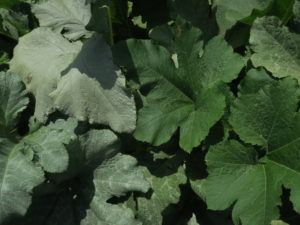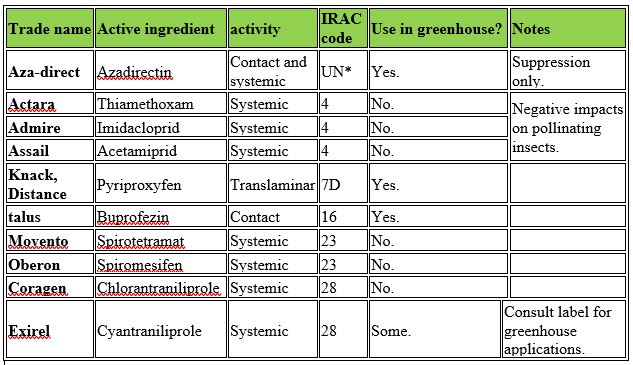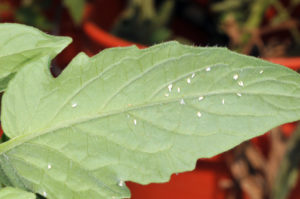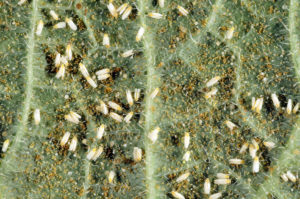Here in Indiana, whitefly problems are rare, but when encountered it is most often in protected ag production (greenhouse or high tunnel) and less often in the field. However, this is the time of year that you may be seeing them in either environment. Whiteflies are not true flies, but rather Hemipteran insects, more closely related to aphids and plant hoppers. They are sap sucking insects that feed on the phloem of the plant, making them efficient vectors of plant pathogens. Whiteflies produce honeydew secretions which can attract other insects or host the growth of sooty mold on infested leaves. There are two main species of whiteflies that may be encountered in Indiana: the greenhouse whitefly (Trialeurodes vaporariorum) and the sweetpotato whitefly (Bemisia tabaci; Figure 1). They can be distinguished by the way in which they hold their wings when at rest on the plant: sweetpotato whiteflies hold their wings tilted against the surface of the plant like a tent while the greenhouse whitefly hold their wings flat, parallel to the leaf surface and appear to be more broad. Regardless of the species, both have large host ranges (feed on many plants) and reproduce quickly in warm temperatures. A single female can lay up to 100 eggs in her lifetime. The eggs, laid on the underside of leaves, are tiny and oblong. They can take up to 6 days to hatch (Figure 2). Upon hatching, the larvae are in a mobile ‘crawling’ stage and find a suitable feeding location on the plant. They become immobile and develop through several larval instars, pupate in place under the larval skin, and the adult emerges approximately 16 days later. Adults can live for several weeks.
Sweet potato whiteflies overwinter in the Gulf region. This is why the presence of the sweet potato whitefly in the Midwest is unusual. This whitefly must be wind-blown to the Midwest, usually in the late summer. Sweet potato whiteflies can cause cucurbits to have a silver leaf symptom (Figure 3). In addition, some whiteflies can transmit serious virus diseases on cucurbits and tomato.

Figure 3. The pumpkin leaves on the left are silvered from feeding by the feeding of the sweet potato whitefly.
In order to prevent infestations in protected environments, careful screening of any new plant stocks should be done. Sanitation is important; remove infested residue as soon as possible. Yellow sticky cards can be used as a monitoring tool, but will not attract and control an infestation. Biological control of this pest is often used in greenhouse settings with much success and is more practical if there are no plant pathogens being vectored by the population. There are two parasitoid wasps commercially available: Encarsia Formosa and Eretmocerus eremicus. Formosa lay eggs in the developing nymphs of the whiteflies, perform better under cooler temperatures and are effective at controlling the greenhouse whitefly. Eremicus also attack the nymph stage of the whiteflies, performs better under warmer temperatures and provides good control of the sweetpotato whitefly. The predatory beetle, Delphatus catalinae, is a predator that will attack all species of whiteflies and avoid those which have been parasitized, so it can compliment either of the aforementioned species of parasitoids. If you are considering biological control, it is imperative to properly identify the pest and release natural enemies at the onset of the infestation. The Purdue Plant and Pest Diagnostic Lab can assist with pest identification.
Insecticides also provide control of whiteflies in greenhouse and field settings (Table 1). A number of neonicotinoid active ingredients are effective against whiteflies including imidacloprid (Admire®), thiamethoxam (Actara®), and acetamiprid (Assail®). Neonicotinoids should be applied with care, as some of these products have been shown to negatively impact pollinating insects. Relatively newer chemistries, like anthranilic diamides and tetramic acids, also offer control of whitefly populations. Effective active ingredients in these classes include cyantraniliprole (Exirel®), chlorantraniliprole (Coragen®), spiromesifen (Oberon®), and spirotetramat (Movento®). Insect growth regulators (IGRs) products, like pyriproxyfen (Knack®) and buprofezin (Talus®), can reduce whitefly populations and may be effective options in greenhouse production. In small scale or organic production systems, azadirachtin (Aza-direct) or insecticidal soaps may be effective and less disruptive to biological control agents.
When using contact insecticides, coverage is key. Whiteflies reside on the underside of leaves, so sufficient coverage of the underside and on overlapping leaves of the plant is crucial to improve the efficacy of applications. Resistance is a concern in whitefly management, and the onset of resistance can be slowed with proper insecticide class rotation and only applying insecticides when needed. Other insecticides, not mentioned here, are available for whitefly management. For a complete listing of chemical recommendations see the ID-56 guide. And remember the label is law, so please consult it before making an insecticide application.
Table 1: Some recommended insecticides for whitefly control.

*unknown mode of action

